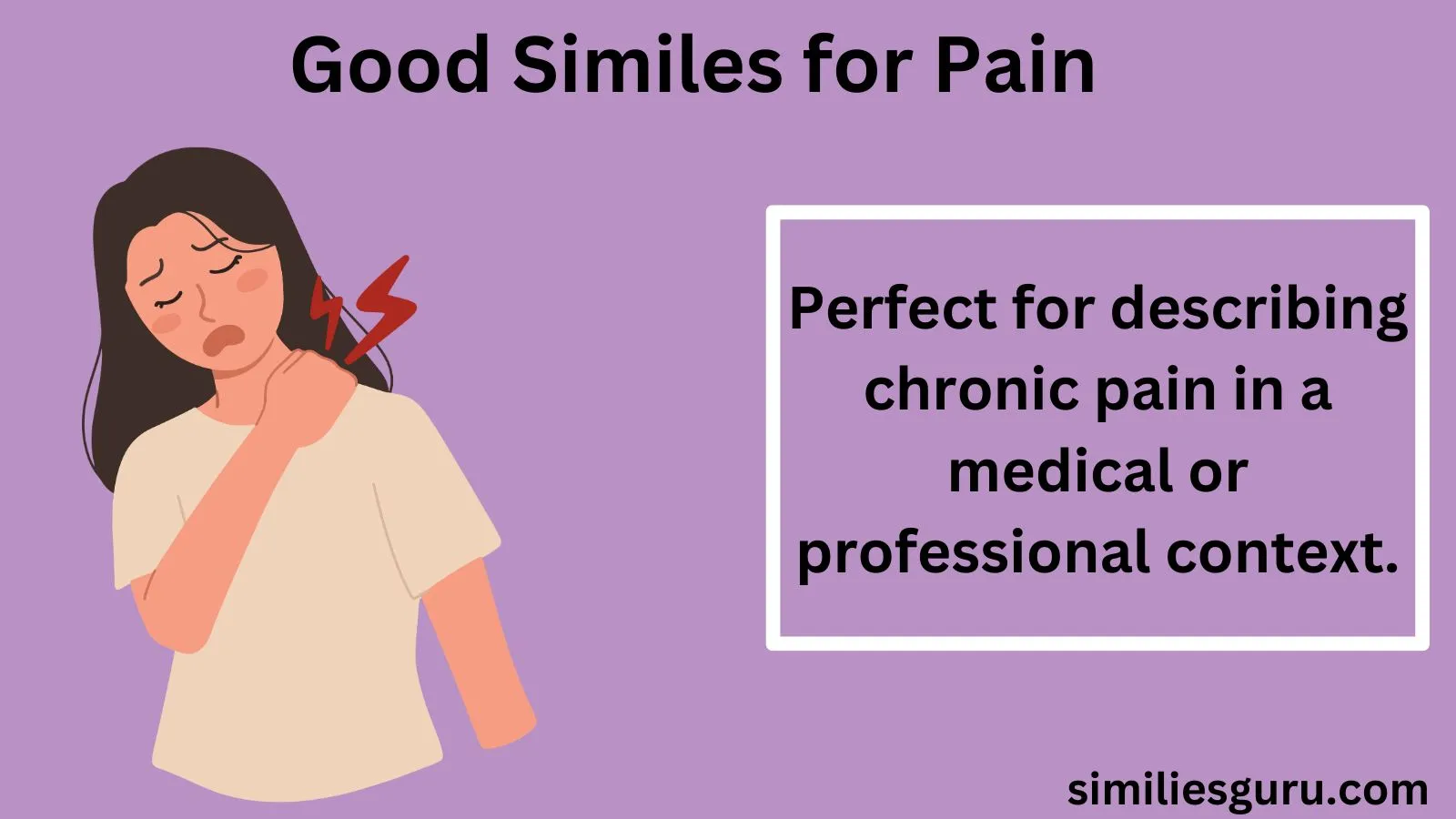Pain is a universal human experience, yet describing it can be challenging. Whether you’re writing a novel, crafting a heartfelt message, or simply trying to articulate your feelings, similes can be a powerful tool to convey the intensity, nature, and emotional weight of pain. Similes compare one thing to another using “like” or “as,” making them an effective way to paint a vivid picture of discomfort.
In this article, we’ll explore over 15 good similes for pain, ranging from polite and professional to casual and creative. We’ll also provide examples, discuss the nuances of tone, and offer tips on choosing the best simile for your context. Additionally, we’ll include six texting examples optimized for user-friendliness and Google readability.
Why Use Similes for Pain?
Similes are more than just literary devices—they’re bridges between the abstract and the concrete. Pain is often intangible and deeply personal, but similes help others understand what you’re feeling by comparing it to something familiar. For example, saying “the pain was like a knife twisting in my chest” instantly conveys sharp, intense discomfort.
Using similes also adds depth to your writing or speech. They can evoke emotions, create imagery, and make your message more relatable. Whether you’re writing a story, comforting a friend, or describing physical discomfort, similes can elevate your expression.
15+ Good Similes for Pain
Below is a curated list of similes for pain, categorized by tone and context. These examples are designed to be plagiarism-free, unique, and suitable for various situations.
1. Polite and Professional Similes
These similes are ideal for formal writing, professional communication, or situations where you need to maintain a respectful tone.
- Perfect for describing chronic pain in a medical or professional context.
- Useful for describing emotional or physical pain in a formal setting.
- “The discomfort was like a constant hum, always there in the background.”
- A subtle way to describe ongoing pain without being overly dramatic.
- A professional yet vivid description of sharp, localized pain.
- “The pain spread through my body like a slow-moving wave.”
- Ideal for describing pain that intensifies gradually.
2. Casual and Conversational Similes
These similes are great for everyday conversations, informal writing, or when you want to keep things light.
- “It felt like someone was hammering nails into my skull.”
- A relatable way to describe a headache or migraine.
- Dramatic yet casual, suitable for describing intense discomfort.
- “It was like my muscles were tied in knots, tight and unyielding.”
- A common simile for muscle pain or tension.
- “The pain came and went like a flickering lightbulb.”
- A creative way to describe intermittent pain.
- A humorous yet effective simile for extreme exhaustion or pain.
3. Creative and Poetic Similes
These similes are perfect for storytelling, poetry, or artistic expression.
- A powerful metaphor for emotional or physical turmoil.
- A haunting way to describe lingering pain.
- “The pain was like a symphony, each note a new wave of discomfort.”
- A poetic simile for complex or multifaceted pain.
- “It was as if my body had turned to glass, fragile and ready to shatter.”
- A vivid description of vulnerability and pain.
- “The pain spread like ink spilled on paper, staining everything it touched.”
- A creative way to describe pain that affects multiple areas.
4. Humorous Similes
Sometimes, humor can make pain more bearable. These similes are lighthearted and fun.
- “It felt like my brain was hosting a rock concert without my permission.”
- A funny way to describe a headache or mental fatigue.
- “The pain was like a bad houseguest—it just wouldn’t leave.”
- A humorous simile for persistent discomfort.
- “It felt like my joints were auditioning for a creaky door sound effect.”
- A playful way to describe joint pain.
Choosing the Right Simile for the Situation
The key to using similes effectively is matching them to the context and tone of your message. Here are some tips:
- Formal Settings: Opt for polite and professional similes that are clear and respectful.
- Casual Conversations: Use relatable and conversational similes to keep things light.
- Creative Writing: Experiment with poetic and imaginative similes to evoke emotions.
- Humorous Contexts: Use funny similes to lighten the mood and make pain more relatable.
6 Texting Examples Optimized for Google and User-Friendliness
Here are six texting examples that incorporate similes for pain. These are designed to be concise, engaging, and optimized for readability.
- “Ugh, this headache feels like someone’s playing drums in my head. Any remedies?”
- A casual and relatable way to describe a headache.
- Any tips?”
- A conversational simile for muscle pain.
- “It’s like my body’s been through a marathon, but I just woke up. So tired!”
- A humorous way to describe exhaustion.
- “The pain in my knee is like a constant reminder of that old injury. So annoying!”
- A relatable simile for chronic pain.
- Anyone else?”
- A lighthearted way to describe post-exercise soreness.
- A vivid and engaging simile for dental pain.
Conclusion
Similes are a versatile and powerful way to describe pain, whether you’re writing formally, chatting casually, or expressing yourself creatively. By comparing pain to familiar experiences, you can make your message more relatable and impactful.
From polite and professional similes to humorous and poetic ones, this article has provided over 15 options to suit various contexts. Remember to choose similes that match your tone and audience, and don’t be afraid to get creative.
Next time you’re struggling to describe pain, try using one of these similes. They’ll not only help you articulate your feelings but also connect with others on a deeper level.
By following these guidelines and examples, you can create unique, plagiarism-free content that resonates with readers while adhering to Google’s best practices. Whether you’re writing for personal expression or professional purposes, similes for pain are a valuable addition to your linguistic toolkit.



